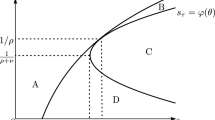Abstract
This study demonstrates the possibility of cyclic capital accumulation in the case in which there are delays in capital implementation and estimation of capital depreciation. For this purpose, a two-sector growth model with Cobb–Douglas production function is built. It is shown that the stability of the balanced growth may change as lengths of delay change. It is also shown that on the stability switching curve the stability is lost and bifurcates to a limit cycle via a Hopf bifurcation.




Similar content being viewed by others
Notes
We can arrive at the same result to be obtained even if \(\nu <0\) is assumed.
Parameters \(\alpha \) and \(\beta \) denote the capital distribution rates of production sectors 1 and 2. It is natural to assume that both are positive and less than unity. \(\theta \) is the sum of the depreciation coefficient and the growth rate of labor (i.e., \(\mu +n\)) that could take a small value. These parameter values are selected for illustration, but other values would not change the qualitative properties shown here.
Mathematica, version 12.1 is used for simulations.
Under the specified parameter values, the trajectory becomes negative for the first time at \(t_{a}\simeq 1027.71.\ \)Since the dynamic system is delayed, it can generate real solutions until \(t= t_{b}\simeq 1078.71\) at which a solution becomes complex. Notice that the difference of the critical times, \(t_{b}-t_{a}=51,\) is equal to the length of the delay.
It is possible that the same region may be considered on the left with respect to one point of the curve and be considered as on the right on another point of the curve.
References
Arrow, K.J., Hurwicz, L.: On the stability of competitive equilibrium I. Econometrica 26, 448–454 (1958)
Arrow, K.J., Brock, H.D., Hurwicz, L.: On the stability of competitive equilibrium II. Econometrica 27, 82–109 (1959)
Day, R.: Irregular growth cycles. Am. Econom. Rev. 72, 406–414 (1982)
Domar, E.D.: Capital expansion, rate of growth and employment. Econometrica 14, 137–147 (1946)
Furuno, Y.: The period of production in two-sector models of economic growth. Int. Econom. Rev. 6, 240–244 (1965)
Gu, K., Nicolescu, S., Chen, J.: On stability crossing curves for general systems with two delays. J. Math. Anal. Appl. 311, 231–253 (2005)
Guerrini, L., Matsumoto, A., Szidarovszky, F.: Neoclassical growth model with two fixed delays. Metroeconomica 70, 423–441 (2019a)
Guerrini, L., Matsumoto, A., Szidarovszky, F.: Neoclassical growth model with multiple distributed delays. Commun. Nonlinear Sci. Numer. Simul. 70, 234–247 (2019b)
Harrod, R.F.: An essay in dynamic theory. Econom. J. 49, 14–33 (1939)
Kalecki, M.: A macrodynamic theory of business cycle. Econometrica 3, 327–344 (1935)
Matsumoto, A., Szidarovszky, F.: Delay growth model augmented with physical and human capitals. Chaos, Solitions and Fractals 130, 109452 (2020)
Matsumoto, A., Szidarovszky, F.: Dynamic Oligopolies with Time Delays. Springer-Nature, Tokyo (2018)
Matsumoto, A., Szidarovszky, F.: Delay differential neoclassical growth model. J. Econom. Behavior Organ. 78, 272–289 (2011)
Nishimura, K., Yano, M.: Nonlinear dynamics and chaos in optimal growth: an example. Econometrica 63, 981–1001 (1995)
Samuelson, P.: On the equilibrium growth of capital and labor, Rev. Econom. Stud., 21, 1-20 (1953-54)
Shinkai, Y.: On equilibrium growth of capital and labor. Int. Econom. Rev. 1, 107–111 (1960)
Solow, R.M.: A contribution to the theory of economic growth. Quarter. J. Econom. 70, 65–94 (1956)
Swan, T.: Economic growth and capital accumulation. Econom. Record 32, 334–361 (1956)
Uzawa, H.: On a two-sector model of economic growth. Rev. Econom. Stud. 29, 40–47 (1961)
Author information
Authors and Affiliations
Corresponding author
Additional information
Publisher's Note
Springer Nature remains neutral with regard to jurisdictional claims in published maps and institutional affiliations.
The authors would like to thank two anonymous referees for careful reading and valuable comments. The first author highly acknowledges the financial supports from the Japan Society for the Promotion of Science (Grant-in-Aid for Scientific Research (C) 20K01566). The usual disclaimers apply.
Rights and permissions
About this article
Cite this article
Matsumoto, A., Szidarovszky, F. Delay two-sector economic growth model with a Cobb–Douglas production function. Decisions Econ Finan 44, 341–358 (2021). https://doi.org/10.1007/s10203-021-00321-2
Received:
Accepted:
Published:
Issue Date:
DOI: https://doi.org/10.1007/s10203-021-00321-2



